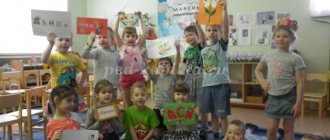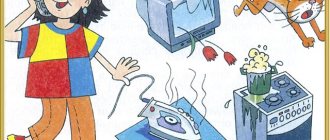Project on the basics of safe behavior for older preschoolers “Safety Space”
4 Try to pick up your child from kindergarten or school yourself. If someone else comes for him, warn the teacher or school teacher about this in advance.
5 Create a password for your child and teach him never to get into a car with a stranger or go anywhere with him if he does not know the password.
6 Convince your child that walking with friends is much safer than walking alone, especially at late times. A criminal is always attracted to a child walking alone.
7 Teach your child how to use a pay phone (including international ones). He should know the home telephone numbers and telephone numbers of help services by heart.
8 Take photographs of your child at least once a year, and the description you have of the child's appearance and special features will help you if he gets lost or kidnapped.
9 Be the kind of parents to whom your child can tell about everything that happens to him. Your child should be confident that you will always love him and will never stop looking for him if he gets lost or kidnapped.
COMMUNICATION WITH STRANGERS: REMINDER TO PARENTS
If a child walks alone on the street or plays in the yard, it is necessary to teach him several rules for safe communication with strangers!
1 Immediately move away from the edge of the sidewalk if a car slows down next to you or if it is driving slowly behind you. No matter what the driver says, you need to stay away from the car.
2 Get away from a stranger who looks suspiciously or wants to get closer. You need to be ready to call for help.
3 Do not get into a car with a stranger if he invites you for a ride.
4 Do not go anywhere with an unfamiliar adult (if he promises to give a toy, candy or show something interesting, introducing himself as an acquaintance of the parents or informing that he is acting at their request).
5 If an unfamiliar adult grabs you by the hand, takes you by the hands, drags you into a car, pushes you into an entrance or some building, you must shout loudly, calling for help and attracting the attention of others: “Help, help, stranger!”
6 Be able to say “NO” to older guys who want to involve them in a dangerous situation (for example, they call them to go see what’s happening at a construction site; light a fire; climb into the attic of a house and climb out onto the roof; go down to the basement; play in the elevator; “experiment” with medicines and odorous substances; climb a tree; climb into someone else’s garden or vegetable garden; go to the forest or to the railway station).
7 Do not enter the entrance alone, without parents or familiar adults. Do not open the door to a stranger, even if the stranger has a gentle voice and introduces himself as someone familiar to his parents and knows their name.
Long-term project for the middle group “Fundamentals of Safety”
Municipal preschool educational institution
“Kindergarten No. 9 “Swallow”, Rtishchevo, Saratov Region”
COGNITIVE – CREATIVE PROJECT
"SECURITY BASICS"
Educator:
Linnik O.V.
2015-2016 academic year
Relevance.
The issue of forming the foundations of life safety is relevant. This is primarily due to society’s need for a socially adapted personality. The uncertainty of the modern environment requires not only high human activity, but also his skills and ability to behave adequately. Preschool age is a period of absorption and accumulation of knowledge. The successful fulfillment of this important life function is facilitated by the characteristic abilities of children of this age: increased susceptibility, impressionability, and a naive and playful attitude towards much of what they encounter. And here the role of the teacher is important, who, by selecting the right methods and techniques, introduces the child into the social world. Safety is not just the sum of acquired knowledge, but the ability to behave correctly in various situations.
Long-term project plan
"Security basics".
- Topic " The ABC of Traffic "
Dates: September - November 2015.
Relevance:
Society faces the question: “How can we make the streets and roads safe for our children?” Through the joint efforts of teachers, parents and the entire society, using knowledge and patience, it is possible to teach children the skills of safe communication with the complex world of roads. Therefore, it became important to search for new interesting forms of working with children and parents.
Target:
Creating the most effective conditions in the group for organizing work to develop children’s skills for correct behavior on the road.
Tasks:
1. Teach children safe behavior on the road.
2. Strengthen children's knowledge of traffic rules: cross the street only with an adult, in strictly designated areas and when the traffic light is green. Expand children's knowledge about traffic lights. To consolidate knowledge about the meaning of traffic lights (pedestrians and cars stand at a red light, prepare to move at a yellow light, and move at a green light).
3. Introduce children to the meaning of road signs, teach them to understand their schematic representation for correct orientation on the streets and roads. Continue to introduce the elements of the road (dividing strip, pedestrian crossing, public transport stop). Remind that pedestrians must cross the road at a surface, underground or pedestrian Zebra crossing. Introduce road signs: “Pedestrian crossing”, “Children”, “Public transport stop”.
4. Consolidate knowledge about special types of transport: “Ambulance” (it goes on call to sick people), a fire truck (it goes to put out a fire), “Police” (it goes to help people in trouble), an emergency vehicle.
5. Strengthen children’s knowledge of the rules of behavior in public transport (you can only ride in public transport with adults; talk calmly without disturbing other passengers; listen to adults; maintain cleanliness and order; you can get out of the vehicle after adults have left, etc. .d.).
6. To cultivate discipline and conscious compliance with traffic rules, a culture of behavior in the road transport process. Tell children that they need to wait at the bus stop for public transport. Explain that public transport stops are located near the roadway, therefore, while waiting for transport, you need to behave calmly (do not run, do not walk on curbs, do not push, do not run out onto the roadway, do not litter, do not shout).
7. Form and develop in children a holistic perception of the surrounding road environment.
8. To develop in children the skills and abilities to monitor the road situation and anticipate dangerous situations, the ability to avoid them, and if they find themselves in such situations, get out of them with the least harm to themselves and others.
9. Expand children's vocabulary in road vocabulary.
10. Intensify efforts to promote traffic rules and a safe lifestyle among parents.
Expected results:
- Conscious attitude of children to the implementation of traffic rules
- Raising a competent pedestrian
- Children’s ability to navigate emergency situations and look for solutions to get out of them
- Reducing the percentage of DDTI (children road traffic injuries) involving children
Implementation stages:
1) Conversation on the picture: “City Street” 2) Story-role-playing game “Traffic Inspector” 3) Game “Driving School” 5) Exhibition of fiction on traffic rules 6) Conversation “Road Rules” 7) Walk “Rules for pedestrians” Game "Safe behavior on the street"
Game "Safe behavior on the street"
9) Presentation for children “On the roads of fairy tales”
10) Quiz “Pedestrian on the street”
11) What kind of sign is hidden in the poems?
12) Word game “What? Where? Where?"
13) Research. Experience “Movement on ice and asphalt” 14) D/I “Can-not, right-wrong” 15) Educational board-printed games
16) Relay “Main Road”
17) Meeting with the traffic police inspector 18) Presenting children with young pedestrian certificates
19) Exhibition of children's drawings: “Our Street”
Working with parents:
- Assisting in creating a developmental environment
- Consultations for parents: “Your child on the street”, “For parents - about road safety”, “Teaching techniques for young pedestrians”, “Teach children correctly”, “Child safety”
- Participation in the exhibition of children's drawings “Our Street”
- Individual conversations: “Do you discuss traffic rules at home with your child? »
Final event:
Round table with parents and children: “To life on a safe road”
II . Topic: “ Fire Safety Lessons ”
Dates: December - February 2015-2016
Relevance:
For as many years as fire has threatened people, they have been trying to find protection from it for almost as long. There are many factors influencing the increase in fires in the modern world, but the most important is the human factor. The problem of fires is acute not only in our country, but also in our village. In recent years, the number of fires caused by humans has increased significantly. Often the cause of a fire is a child's prank. Parents do not take this problem seriously enough. Children are allowed to play with flammable objects; for many, a lighter is a familiar toy. In order to change a person’s attitude towards this problem, it is necessary to begin to deal with this problem already at the preschool stage of the child’s development. It is necessary to change people's consciousness and attitude towards fire safety, and childhood is the most favorable age for the formation of fire safety rules. The kindergarten and parents need to join forces; in order to protect children from possible tragedy, targeted work is needed to develop a culture of fire-safe behavior in them.
Problem:
children do not have a clear understanding of the hidden danger of fire, playing with matches, explosive and flammable objects.
Target:
developing in children knowledge about fire safety, skills of conscious, safe behavior, creating conditions for assimilation and consolidation of the knowledge of children and their parents about fire safety rules.
Tasks:
Educational
- Introduce the history of fire.
- Give children the idea that fire can be a friend, but it can also be an enemy.
- . To form an idea of situations dangerous to humans that lead to fires.
- Concretize ideas about how to behave in dangerous situations (fire) and ways to avoid such situations
- Teach children to see when fire is friend and when it is enemy.
Developmental
- Develop the ability to realistically assess possible danger.
- Help children remember fire safety rules.
- To develop such integrative personality traits of preschoolers as curiosity, activity, the ability to manage their behavior and plan their actions based on primary value ideas about their own safety.
- Develop the creative abilities of preschoolers
Educational
- Foster a sense of caution and self-preservation.
- To instill self-confidence in children and prevent fear of fire.
- Cultivate feelings of gratitude to people who help us in difficult situations.
Practical
- To instill practical skills in children’s behavior in the event of a fire.
- Teach basic steps to extinguish a fire.
- Show parents the knowledge and skills children acquired during the project.
- Involve them in the educational process of preschool educational institutions
Expected result:
• Children's attitudes towards their safety and health will change.
• They will learn the correct actions to take in the event of a fire.
• Children will be able to conduct a role-playing dialogue with the dispatcher of service “01” and give all the necessary information about themselves.
• The competence of participants in the pedagogical process on fire safety issues will increase.
• There will be professional personal growth of the teacher on this topic.
• Parents will be interested in this problem and in the process of implementing the project will become my like-minded people.
Implementation stages:
- Didactic and board games: Guessing riddles on a fire theme, “It burns, it doesn’t burn,” “Fire extinguishing equipment,” “Finish the sentence,” “Say the word,” “Causes of fires,” “Mute telephone,” “The fourth wheel,” puzzles “ Fire”, “Loto”, “Collect a picture”.
- Outdoor games “Brave Firemen”, “Firemen in Exercises”, “Young Firefighter”, Relay Race “Rescue the Victims”
- Role-playing games: “Fire department”, “We are firefighters”, “Brave firefighters”, “Rescue service”.
- Conversations and educational activities “Fire is our friend” “Firefighter is a heroic profession”, “Causes of fire”, “On the benefits of household electrical appliances and the rules for using them”, “What to do in case of a fire”, “How fires happen”, “If there is a lot of smoke in the apartment”, “If the fire siren sounds”, “Dangerous lights. Rules of conduct near the Christmas tree"
- Tour of the kindergarten (introduction to the fire safety corner).
- Productive activity: Drawing “Fires happen...”, Application “Fire truck”, Modeling from plasticine “01”
- Presentation “Fire in pictures and riddles”
- Reading literature: V.A. Stepanov “ABC in riddles”, S.Ya. Marshak “Fire”, “The Story of an Unknown Hero”, “Cat’s House”, L.N. Tolstoy “Fire Dogs”, B. Zhidkov “Fire at Sea”, “Smoke”, “Fire”, K. Chukovsky “Confusion”.
Working with parents:
- Assistance in creating a subject-development environment for fire safety.
- Information in the parent's corner about fires and deaths in the Rtishchevsky district for 2015.
- Participation in the exhibition of children's drawings “Me and the Fire”
- Consider illustrations depicting the work of firefighters in books and magazines, bring books to kindergarten.
- Consultations for parents: “The safety of our children is in our hands”
- Individual conversations: “Do you discuss the topic of the week with your child at home?”
Final event:
- Organization and participation of parents in a fire-themed exhibition.
- Conducting the final event “It’s time for small children to know that matches are a terrible game!”
III .
Topic “When I'm home alone”
Dates March 2016
Relevance:
K. D. Ushinsky wrote, “education reduces the number of dangers that threaten our lives, reduces the number of causes of fear and, by making it possible to measure the danger and determine its consequences, reduces the intensity of fear due to these dangers.”
Today's children need to be taught special skills so that they can avoid a wide variety of dangers. Teach children to assess the environment, identify potential dangers, suspicious situations and respond adequately to them.
Target:
To form in children an idea of dangerous objects that are found in everyday life, the necessity of these objects for humans, and the rules for using them. To give each child the basic concepts of life-threatening situations and the characteristics of behavior in them, to develop in children the skills of conscious safe behavior at home when a stranger knocks on the door.
Tasks:
1. Create conditions for activating the mental activity of children. Use various means and forms of work to help children learn the rules of safe behavior in conditions when the child is home alone within the framework of the topic of children and other people.
3. Teach children to use the acquired knowledge in practice.
4. Consider and discuss with children such dangerous situations as contacts with strangers, teach them to behave correctly in such cases.
5. Develop in children the ability to foresee possible danger in a specific changing situation and build adequate safe behavior.
6. To form children’s ideas about the dangers when handling various objects in everyday life; give children knowledge about the rules for using piercing, cutting, and flammable objects;
7. Form coherent speech, make your own conclusions; Develop attention and thinking when solving problem situations.
8. Consult parents on how to explain to their child that good intentions and appearances may hide deception.
9. Teach every child in a dangerous situation to call the helpline, know their address and location of the house.
Expected results:
- Children expand their knowledge about the rules of safe behavior at home, on the street, and in life- and health-threatening situations.
- Learn how to properly handle household items
- Get an idea of the work of rescue services and learn the telephone numbers where you can get help
Implementation stages:
- Conversations:
“Home alone”, “Household chemicals”, “Gas”, “Electricity”, “First aid for electric shock”, “Rules for handling fire”, “How to protect yourself from burns”, “Sudden collapse of a building”, “You know” Do you have your address, telephone number and can you explain where you live?”
- Classes:
"Our assistants." "Stranger. Rules for safe behavior." “Treasures of Children’s Pockets” “Medicines – Friends or Foes”
- Looking at thematic pictures
"Safety rules at home and on the street"
- Didactic games:
"Magic Phones", "The Fourth Wheel"
- Reading fiction:
Russian folk tale “Zayushkina’s Hut”, “The Wolf and the Seven Little Goats”, “Sister Alyonushka and Brother Ivanushka”, S. Marshak “The Tale of the Stupid Little Mouse”
- Memo for children and parents
“The simplest and most important safety rules”
- Illustrative material on the topic
“Dangerous household items”, computer presentation, sliding folder with rules for children and parents “Alone - at home”
Final event:
themed entertainment "Home Alone"
IV .
Topic “The Amazing World of Insects”
Dates: April 2021, 1 week
Relevance:
Introducing children to nature through instilling love and respect for it is one of the most important tasks of teachers when working with preschool children. Children should understand that many insects play a huge role in the life of various plants and animals, and children should also clearly understand the dependence of the number and viability of insects on the ecological state of the environment. In the process of implementing this part of the project, children learn about the world of insects, learn to look at it from the side of real researchers, biologists, learn to take care of all living things, take care of preserving the insect population; note the diversity of their types, the unusualness of their forms, appearance and purpose. Children will also learn how to behave when bitten by insects.
Target:
- To consolidate children's knowledge about the external structure of the body of insects, the names of individual parts of the body (head, abdomen, wings, legs).
- To deepen children's knowledge about the diversity of insects inhabiting our native land, learn to distinguish them from each other, identify the degree of their significance for the nature around us
- Develop a caring attitude towards living nature
- To develop knowledge about the benefits and harms of insects for people and plants
Tasks:
- Expand children's knowledge and enrich their vocabulary about new insects unknown to them, as well as about their appearance, structural features, behavior, and significance in nature.
- To instill in children a love of nature, to form a caring attitude towards “our little brothers”
- Strengthen the ability to reproduce received impressions in creative activities.
- Talk about the benefits (harm) of insects for people and plants.
Expected results
:
- Enrich and systematize children's knowledge about insects;
- Have an idea about the peculiarities of body structure, coloring, camouflage, in connection with their life, about the uniqueness of each species;
- Know about the benefits and harms of various types of insects for the environment.
- Have an idea of the dependence of the normal existence of insects on the ecological state of the environment.
Implementation stages:
- Conversations:
“Insects are our enemies and friends”, “Beneficial insects” “Dragonflies, butterflies, bees, grasshoppers” “Ants and anthills”
- Looking at thematic pictures
"Insects"
- Didactic games:
“The fourth odd one”, “Find a pair”, “Collect a picture”
- Reading fiction:
Reading: • V. Bianki “Like an ant hurried home.” • V. Bianchi “Red Dot”. • V. Samuylov “Where Venus’s slipper grows.” Memorization: • Krylov “The Dragonfly and the Ant.” • K. Chukovsky “The clattering fly.” Puzzles. Eco-training “If I were an insect.” Problem situations “What would happen if there were no mosquitoes or butterflies?” Music: song “A grasshopper sat in the grass.”
- Final event:
panel "Insects"
V. _
Topic “Domestic and homeless animals”
Dates April 2021, 2nd week
Relevance:
Target.
To provide knowledge about the rules of behavior when meeting and communicating with various domestic and stray animals.
Tasks.
Teach children to understand the condition and behavior of animals.
Teach careful handling of animals, explaining that contact with them can be dangerous.
Help children learn and remember the rules of proper handling of pets and stray animals.
Promote speech development, enrich vocabulary.
Develop creative thinking, improve memory, activate attention.
Foster a humane, caring attitude towards animals.
Implementation stages:
- Conversation:
“Safety rules for contact with animals”, “Belka and Strelka - the first cosmonaut dogs”
- Didactic games:
"Name the Babies", "Pets", "Wild Animals"
- Outdoor games:
“Cat and Mice”, “Shaggy Dog”, “At the Bear in the Forest”, “Geese”
- Reading fiction:
Russian folk tale “Winter quarters of animals”, Lebedeva G.V. “Pig tails”, Nosov N.N. “The Living Hat” “Bobik visiting the watchdog”
- Children's speech development:
Compiling the story “My Favorite Pet”
- Artistic creativity:
Creative works at the request of children “Belka and Strelka in space”, modeling “My favorite pet”
VI .
Topic “Mushrooms”
Dates April 2021, week 3
Relevance:
Nature gives us a lot of beautiful, tasty, healthy things. Autumn is especially generous with gifts. How many delicious fruits and vegetables ripen in people’s gardens, how many bright flowers bloom in their gardens. There are also countless gifts that nature gives without requiring any effort from humans. These include berries, mushrooms, and medicinal herbs. Every person should love and take care of nature. And you need to instill love for it from early childhood. So in kindergarten we constantly address this problem, considering it with children from all possible angles. In order for a child to have a desire to preserve and protect nature, he must learn to see its beauty and understand its value for humans. Not every modern parent goes into the forest with their children. But it is impossible to get to know nature closely enough without visiting the forest at different times of the year.
Target:
expand children's understanding of the forests of their native land in general and mushrooms in particular through the organization of various types of activities, create conditions for increasing the active participation of parents in the life of the kindergarten and group.
Objectives:
Educational:
to cultivate in children a love and caring attitude towards nature, to show the value of nature and its gifts for every person.
Educational:
to form in children knowledge about mushrooms and their types, about the value of mushrooms for humans and animals, birds, to expand knowledge about the forests of their native land, to teach them to understand mushrooms, and to show concern for nature.
Developmental:
develop curiosity, observation, develop children's creative abilities, involve parents and children in joint activities.
Problem:
children do not have sufficient knowledge about mushrooms growing in the forests of the Ural region.
Expected results:
nurturing a caring attitude towards nature, expanding children’s knowledge about mushrooms and their value for humans, involving parents and children in joint activities, establishing trust and partnership relationships with them.
Implementation stages:
- Conversation:
“Mushrooms”, “Who benefits from mushrooms”, “Rules of behavior in the forest”, “What types of mushrooms are there”
- Didactic games:
Printed board game “Animals of our forests”, lotto “Who Lives Where”, “Vegetables, Fruits”.
- Role-playing game “Family”, “In the Forest”, “Shop”, “Hospital”.
- Outdoor games:
“Cat and Mice”, “Shaggy Dog”, “At the Bear in the Forest”, “Geese”
- Reading fiction:
Reading proverbs and sayings about mushrooms, solving riddles.
- Children's speech development:
Word games “Who lives where? ", "Say the word", "Correct the mistake", "Continue the story", "Edible, inedible."
- Artistic creativity:
Application made of colored paper “Brothers - Mushrooms”, Application made of colored paper and dry leaves “Autumn Guest”, Modeling of various mushrooms: boletus, chanterelle, boletus.
Final event:
Design of an exhibition of children's works in the group “All mushrooms are good!”
VII . Theme "Safety Week"
Dates April 2021, week 4
Repetition of covered material
Final entertainment “Arkady Parovozov’s School”
10




